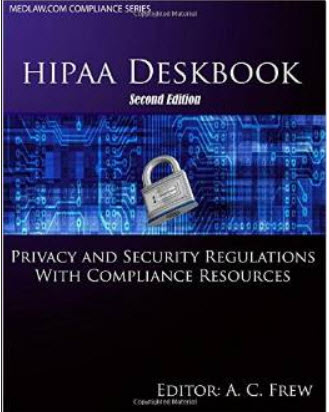 My daughter has just released the second edition of her HIPAA Deskbook on Amazon. She used college vacations to expand the previous edition by more than 100 pages at dad’s prompting so I would have an expanded resource on my desk rather than searching a computer.
My daughter has just released the second edition of her HIPAA Deskbook on Amazon. She used college vacations to expand the previous edition by more than 100 pages at dad’s prompting so I would have an expanded resource on my desk rather than searching a computer.
I like to highlight and mark frequently-used sources and keep an actual book on my desk for reference. I use it too — just yesterday I answered a nurse’s HIPAA question with “chapter and verse” in just a few seconds because I had her beef-up the index for quick reference.
I also hope that it will result in fewer calls home for bank account deposits from dad. (Four years down next month and then only two more to go.)
Here’s the Amazon description:
This is the HIPAA Privacy and Security reference for healthcare providers, business associates, privacy officers, attorneys, and compliance officers who prefer hard-copy reference materials within easy reach. Official government materials have been arranged to put the authoritative language at your fingertips.
More than 100 pages of new materials have been added to the first edition (2013) to give you critical documents, including:
- The Omnibus Regulation updated Security and Privacy regulations
- Office of Civil Rights (OCR) audit standards that describe exactly what auditors are to ask for in terms of documentation
- OCR Sample format for Notice of Privacy Practices • OCR Sample Business Associates Agreement
- OCR guidance on Risk Analysis Requirements under the HIPAA Security Rule (with carry-over for meaningful use expectations)
- Self-assessment checklists for physical safeguards, administrative safeguards, and technical safeguards for Risk Analysis compliance
- OCR sample list of interviews and questions for a HIPAA onsite compliance investigation
- HHS guidance on HIPAA when communicating with a patient’s family, friends, or others
- HHS guidance on Disclosure to Law Enforcement
- HHS guidance to law enforcement on HIPAA restrictions and permitted disclosures
- HHS Frequently Asked HIPAA Questions
This reference features a heavily detailed Table of Contents and Index for quick access to important points.
The direct link to the Amazon page is: www.amazon.com/HIPAA-Deskbook-Regulations-Assessment-Standards/dp/1508439222/ref=sr_1_1?ie=UTF8&qid=1429034627&sr=8-1&keywords=hipaa+deskbook
Hello,
Hello,
A question has come up about the following scenario: A community’s major hospital (tertiary care, 4 ICUs, Level II Trauma, etc) is full and on ICU divert; their patient access center gets a call from a CAH requesting an ICU bed; the access center finds a bed in a hospital 30 miles away rather than at the other community hospital in town. The hospital to which the patient was referred is not affiliated in any way with the major hospital. Is it an EMTALA violation to bypass the other local hospital in order to send the patient to the one 30 miles away? This assumes the decision was not made for medical reasons. I believe it might be, if a hospital skipped over closer faciities just to send a patient to another hospital in their own system, but wasn’t sure if it would be in the situation above. Thank you. Congratulations to your daughter on her book; we will check it out. Do you know when the next edition of your EMTALA handbook will be out? Thanks.
CAH making the request is responsible for the decision of where they send the patient. The recommendation from the major hospital is just that … a recommendation offered when they have to turn down the patient. Since a 30 mile transfer of someone needing ICU is potentially detrimental, the CAH would be well-advised to check locally before deciding on the destination, assuming that closer hospitals have the capability required for the patient. Ultimately, however, CMS will look at whether the destination hospital is capable of caring for the patient and whether it accepted.
CMS may — but not always — look at the risk/benefit of the longer transfer vs not even asking about the closer one. This is likely to come up if there is a deterioration during transfer. The potential violation here will rest on the CAH as the sending facility. If there is any indication that financial considerations of the CAH played into the destination selection, this will increase CMS concern.
The major facility is only at risk if CMS determines that ICU divert does not meet the EMTALA standard which says if they have a bed open in the facility as a whole vs in the unit, they cannot refuse transfer. Diversion standards for presenting patients are different than the standard for refusing transfers.
As for the next edition of the EMTALA Field Guide, we just started revision planning which typically takes approximately a year, plus I have a FQHC risk book revision underway, so it definitely will be May or June 2016 for the next edition release. We are also looking at an EMTALA seminar possibility and an online EMTALA classroom development this year since I seem to have a tendency to overload my schedule.
Where can I get a desk copy of this if i was interested in using it in my college class i teach?
Contact me using the Ask A Question button on the Medlaw.com website.